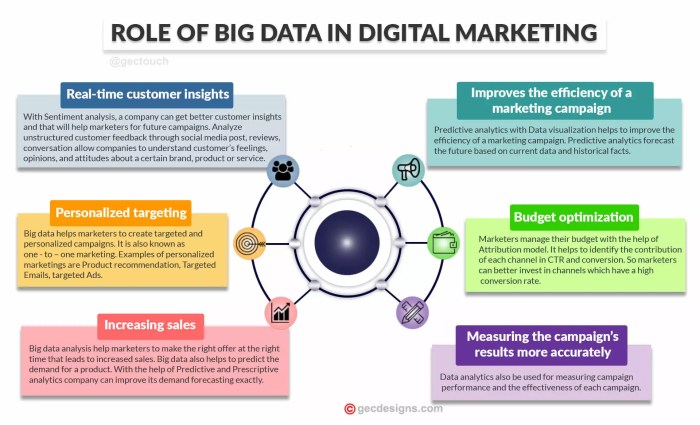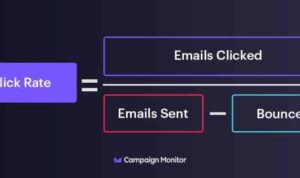Using Data Analytics in Digital Marketing takes center stage, inviting readers into a world of knowledge and insight. Get ready to dive deep into the realm of optimizing marketing strategies through data analytics.
In the realm of digital marketing, data analytics plays a crucial role in understanding customer behavior, improving targeting strategies, and measuring campaign performance. Let’s explore how data-driven decisions can revolutionize your marketing efforts.
Introduction to Data Analytics in Digital Marketing
Data analytics plays a crucial role in the field of digital marketing, providing businesses with valuable insights to make informed decisions and optimize their marketing strategies. By analyzing data from various sources, marketers can better understand consumer behavior, preferences, and trends in order to create targeted campaigns that resonate with their audience.
The Importance of Data Analytics
- Data analytics allows marketers to track and measure the performance of their marketing efforts in real-time, enabling them to make adjustments and improvements on the fly.
- By leveraging data analytics, businesses can identify the most effective channels, messaging, and offers that drive the highest return on investment (ROI).
- With the help of data-driven insights, marketers can personalize their marketing campaigns to deliver more relevant and engaging content to their target audience.
Types of Data Used in Digital Marketing Analytics

In digital marketing analytics, various types of data are utilized to understand consumer behavior, improve marketing strategies, and drive business growth.
First-Party, Second-Party, and Third-Party Data
First-party data refers to information collected directly from customers through interactions with a company’s website, social media platforms, or other owned channels. This data is highly valuable as it offers insights into individual customer preferences, behaviors, and purchase history.
On the other hand, second-party data involves sharing first-party data with trusted partners or collaborators. This shared data allows companies to enhance their understanding of customers and target audiences, leading to more personalized marketing efforts.
Third-party data, on the other hand, is purchased from external sources and provides additional information about consumer demographics, interests, and behaviors. This data is beneficial for expanding reach, targeting new audiences, and enriching existing customer profiles.
Customer Data, Behavioral Data, and Engagement Data
Customer data includes information such as demographics, contact details, and purchase history, helping businesses create personalized marketing campaigns and improve customer retention strategies.
Behavioral data tracks consumer actions online, such as website visits, clicks, and interactions with content. Analyzing this data provides insights into consumer preferences, interests, and intentions, enabling marketers to optimize their digital campaigns for better performance.
Engagement data measures how consumers interact with marketing content, such as email open rates, social media shares, and video views. By analyzing engagement data, marketers can gauge the effectiveness of their campaigns, identify areas for improvement, and tailor future strategies to enhance customer engagement and drive conversions.
Tools and Technologies for Data Analytics in Digital Marketing
Data analytics tools are essential for digital marketers to gather insights and make informed decisions. Let’s explore some popular tools used in the industry and how they contribute to successful campaigns.
Google Analytics
Google Analytics is a powerful tool that provides detailed insights into website traffic, user behavior, and conversion rates. Marketers can track key metrics such as page views, bounce rates, and goal completions to optimize their online presence. With features like real-time reporting and audience segmentation, Google Analytics helps marketers understand their target audience and tailor their strategies accordingly.
Adobe Analytics
Adobe Analytics offers advanced analytics capabilities, allowing marketers to analyze customer interactions across various channels. This tool provides comprehensive data on customer journeys, enabling marketers to identify trends and patterns that drive conversions. With features like predictive analytics and AI-driven insights, Adobe Analytics empowers marketers to create personalized experiences for their audience.
SEMrush
SEMrush is a popular tool for competitive analysis and research in digital marketing. Marketers can uncover valuable data on competitor strategies, rankings, and backlink profiles to enhance their own campaigns. With features like tracking and site audit, SEMrush helps marketers optimize their efforts and improve their online visibility.
AI and machine learning play a crucial role in enhancing data analytics capabilities for marketers. These technologies enable marketers to analyze vast amounts of data efficiently, identify patterns, and predict future trends. By leveraging AI-powered tools, marketers can make data-driven decisions, personalize customer experiences, and stay ahead of the competition in the dynamic digital landscape.
Data Visualization Techniques for Digital Marketing Insights

Data visualization plays a crucial role in presenting marketing insights as it helps in transforming complex data into easily understandable visual representations. By using charts, graphs, and dashboards, businesses can effectively communicate trends, patterns, and relationships within the data to make informed decisions.
Charts
Charts are a popular data visualization technique that can be used to showcase data trends over time or compare different metrics. For example, line charts can display changes in website traffic or social media engagement, while pie charts can illustrate the distribution of marketing budget across various channels.
Graphs
Graphs are another effective way to visualize data in digital marketing. Bar graphs can be utilized to compare performance metrics between different campaigns or platforms, while scatter plots can show the relationship between variables such as ad spend and conversion rates. Graphs help marketers quickly identify correlations and outliers in the data.
Dashboards
Dashboards are comprehensive visual displays that provide an overview of key performance indicators (KPIs) and metrics. They allow marketers to monitor real-time data, track progress towards goals, and identify areas that require attention. Dashboards can consolidate data from multiple sources into a single interface for easy analysis and decision-making.
Personalization and Targeting Strategies with Data Analytics: Using Data Analytics In Digital Marketing
Personalization and targeting strategies with data analytics play a crucial role in digital marketing, allowing businesses to create more tailored and effective campaigns. By leveraging data analytics, marketers can gain valuable insights into consumer behavior, preferences, and demographics, enabling them to deliver personalized content and offers to the right audience at the right time.
Role of Personalization in Digital Marketing, Using Data Analytics in Digital Marketing
Personalization in digital marketing involves customizing content, product recommendations, and marketing messages based on individual customer data. By analyzing data such as browsing history, purchase behavior, and demographic information, marketers can create personalized experiences that resonate with their target audience. This not only helps in increasing customer engagement but also boosts conversion rates and customer loyalty.
- Personalized Email Campaigns: Using data analytics, marketers can segment their email lists based on customer preferences and behaviors to deliver targeted and relevant content. This approach has been shown to significantly increase open rates and click-through rates.
- Dynamic Website Content: By analyzing user data, marketers can personalize the content displayed on their websites to match the interests and preferences of individual visitors. This can lead to higher engagement and longer time spent on the site.
- Customized Product Recommendations: E-commerce businesses can use data analytics to recommend products to customers based on their past purchases, browsing history, and demographic information. This personalized approach often results in higher conversion rates and increased customer satisfaction.
Role of Segmentation and Targeting in Digital Marketing
Segmentation and targeting involve dividing a target market into smaller, more defined groups based on specific characteristics such as age, gender, interests, and purchasing behavior. Data analytics enables marketers to identify these segments and tailor their marketing strategies to address the unique needs and preferences of each group. This targeted approach helps in improving campaign effectiveness and ROI.
- Behavioral Segmentation: By analyzing customer behavior data, marketers can segment their audience based on actions such as website visits, clicks, and purchases. This allows for more personalized messaging and offers that are relevant to each segment.
- Geographic Targeting: Data analytics can help businesses identify the geographic locations of their target audience and tailor their marketing efforts to suit the preferences and needs of customers in different regions. This ensures that marketing messages are more relevant and impactful.
- Psychographic Segmentation: Marketers can use data analytics to understand the psychographic profiles of their customers, including values, beliefs, and lifestyle preferences. This information can be used to create targeted campaigns that resonate with specific customer segments.
Examples of Successful Personalized Marketing Strategies
One notable example of successful personalized marketing is Amazon’s recommendation engine, which uses data analytics to suggest products to customers based on their browsing and purchase history. This personalized approach has led to a significant increase in sales and customer retention for the e-commerce giant.
Another example is Spotify’s personalized playlists, which are curated based on user listening habits and preferences. By leveraging data analytics, Spotify delivers a unique and tailored music experience to each user, resulting in higher user engagement and satisfaction.
Overall, personalization and targeting strategies powered by data analytics are essential for modern digital marketing efforts, enabling businesses to connect with their audience on a more personal level and drive better results.
Performance Measurement and Optimization through Data Analytics
Data analytics plays a crucial role in measuring the performance of digital marketing campaigns. By analyzing various metrics and data points, marketers can gain valuable insights to optimize their strategies for better results. Let’s explore how data analytics aids in performance measurement and optimization.
A/B Testing
A/B testing is a common optimization technique used in digital marketing to compare two versions of a webpage, email, or ad to determine which one performs better. Data analytics helps in setting up these tests, analyzing the results, and making data-driven decisions to improve conversion rates.
Conversion Rate Optimization
Conversion rate optimization (CRO) focuses on improving the percentage of website visitors who take a desired action, such as making a purchase or filling out a form. Data analytics provides insights into user behavior, helping marketers identify areas for improvement and test different strategies to increase conversions.
Iterative Data Analysis
The process of analyzing data for marketing optimization is iterative, meaning it involves continuously reviewing and refining strategies based on data insights. Marketers use data analytics tools to track key performance indicators (KPIs), identify trends, and make data-driven decisions to enhance marketing performance over time.
